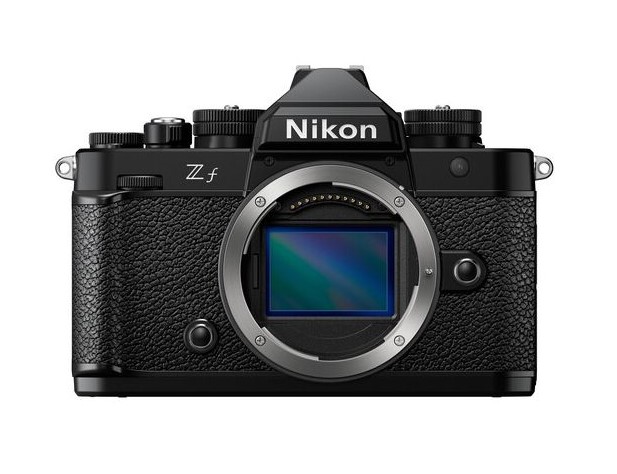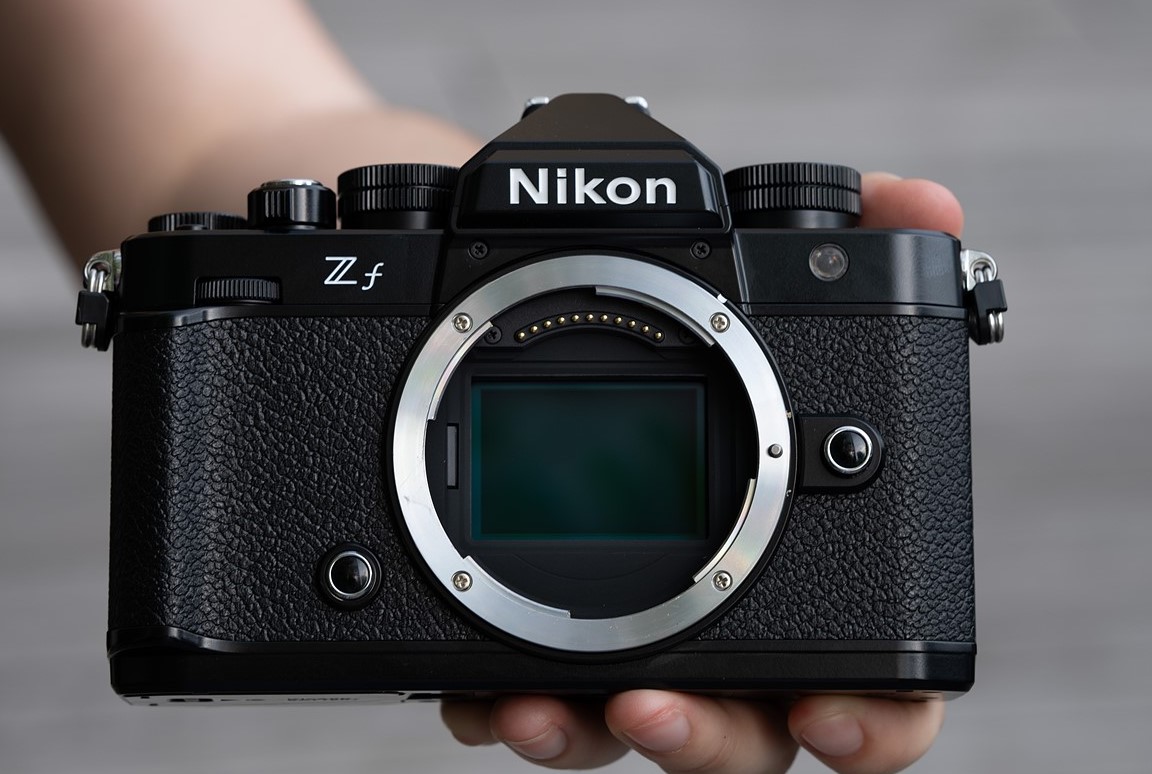
Nikon Zf - full-frame image quality, depth and dynamic range; autofocus developed with deep learning technology; amazing low-light performance and image stabilisation. The Nikon Zf is a classically styled full-frame mirrorless camera based on a 24 MP BSI CMOS sensor. It is designed to mimic the look of the company's FM2 SLR from the early 1970s, making it effectively the full-frame equivalent of the company's Z fc APS-C camera. The Nikon Zf uses the same EN-EL15c battery as most of Nikon's mid-range cameras, allowing it to take 380 photos (LCD) and 360 photos (EVF) on a single charge. These figures increase to 430 and 410 photos on a single charge when the power saving mode is activated. Charging is done via the camera's USB-C port, which, unlike the Nikon Z8, has only one.

Nikon does not claim that the Nikon Zf 24 MP BSI CMOS sensor is new and, apart from the increased AF coverage, most of the parameters are the same as those of the older, but well regarded, Nikon Z6 II sensor. However, the introduction of the latest Expeed 7 processor has brought significant changes. In particular, it adds object recognition to the camera's AF system, as well as the company's Nikon Z9-like implementation of 3D tracking, along with a Type 9 object recognition system. In addition, contextual noise reduction has been introduced, which more aggressively smooths out areas that appear to be lacking in detail. It was this noise reduction in JPEG and HEIF files that persuaded Nikon to allow the camera's ISO range to be expanded to 204 800 (the unexpanded limit also increases to 64 000). The move to the latest processor also allows the Nikon Zf to capture Raw files compressed using the more efficient high-efficiency compression system that we first saw in the Nikon Z9. The 11fps rate is apparently highest in Raw mode (in the continuous high-speed mode, which presumably won't include the live preview refresh between frames), and up to 15 or 14fps in JPEG mode, depending on whether an electronic or mechanical shutter is used. There is also a JPEG-only mode "C30" which uses a video stream of 30fps to capture images, with a pre-shutter option, like the Nikon Z8 and Nikon Z9.

The camera's B&W mode, which allows you to select the shooting and video recording mode, has its own place in the controller, where you can select from a range of mono profiles, including low-contrast 'flat mono' and 'deep tone mono', which brings out the red details in the scene. These profiles can be applied to both stills and video footage and underline Nikon's focus on the creative process.
Unlike the Nikon Df, which promised purity of photography while forgoing video features, the Nikon Zf is a camera that is quite capable of shooting movies. It can shoot up to 4K/60 from a cropped APS-C (DX, in Nikon parlance) sensor, or it can shoot 4K at up to 30p from a full 6K pixel wide sensor. Waveforms are also added to help when trying to judge the exposure of the video, especially now that we have 10-bit internal recording to allow Log recording.
"Nikon joins camera manufacturers who use image stabilisation to offer a multi-photo pixel shift mode, where the sensor is moved in precise degrees to capture every colour at every pixel or sub-pixel to increase the resolution of the output image. The Nikon system offers four modes, all of which require the Raw files to be merged in desktop software: a four-shot mode that captures the full colour at every pixel, an 8-shot mode that does this twice to further improve tonal quality and noise, a 16-shot mode that also increases the resolution of the image to 96 MP, and then a 32-shot version that also doubles this resolution.

As companies strive to maximise the performance of their IS systems, it is becoming increasingly difficult to offer additional enhancements. Nikon claims that the Nikon Zf's performance is improved by linking the IS system to a selected autofocus point. The logic is that pan and tilt movements (tilting up/down and rotating left and right) cause greater off-centre image shifts, especially with wide-angle lenses. The Nikon Zf IBIS system can use the selected autofocus point as the centre point of its corrections, rather than the centre of the image, helping to provide more effective stabilisation when using off-centre autofocus points with wide lenses. This technique should help to maintain sharpness at the point of focus, which helps the camera to achieve a stabilisation rating of 8 EV when tested to the CIPA standard.
The most obvious thing that can be said about the Nikon Zf body is that it is very similar to the Nikon FM2 film camera of the 1970s. Placed side by side, it's clear that the new camera is bigger, but the proportions have been maintained so it still looks like it did before. The construction of the Nikon Zf is essentially magnesium alloy (with a few plastic plates acting as a radio window for Wi-Fi), which, according to Nikon, is "dust- and drop-proof". Keeping with the traditional look means that there is no protruding grip, but as with the FM2 and cameras of similar vintage, it can be used quite comfortably. The extra few millimetres of depth makes it easy to grip and the dials are well positioned so that they can be operated without feeling like you are going to drop the camera. The smaller Nikon Z fc has been criticised for looking flimsy due to its low weight, an impression that is reinforced by the rather plasticky dials. The larger Zf's weight avoids this problem: it looks sturdier and the feel of the control buttons is consistent with this.
"Nikon provided two card slots for the Nikon Zf, but in order to control the size of the Zf, Nikon decided that the second card slot would be a MicroSD type. These cards are quite small and can be difficult to insert and remove from the camera, so it may make sense to always leave a fast microSD card in the camera as a redundant card, rather than planning to remove it frequently. However, the SD slot is compatible with UHS II and the Micro SD only with UHS I.

- 24 MP full-frame BSI CMOS sensor.
- In-house image stabilisation up to 8EV.
- Special monochrome mode.
- Up to 14 fps continuous shooting (JPEG), 11 fps Raw.
- C30 JPEG-only 30fps mode with pre-shooting function.
- AF system with 9 subject types tracking and recognition.
- 4K/60 video from 6K recording with 10-bit N-Log recording.
- 32-frame high resolution mode for 96 MP images.
- SD and MicroSD card slots.
Lens connector: Nikon Z mount
Manufacturer: Nikon
Effective pixel count: 24.5 megapixels.
35.9 mm x 23.9 mm
Image sensor format: FX
Image sensor type: CMOS
Total pixels: 25.28 million.
JPEG: JPEG-Baseline compatible with fine (approx. 1:4), normal (approx. 1:8) or master (approx. 1:16) compression; size-priority and optimum quality compression available; NEF (RAW) + JPEG: One image recorded in NEF (RAW) and JPEG formats; NEF (RAW): 14-bit lossless, high-efficiency* or high-efficiency compression; HEIF: supports fine (approx. 1:4), normal (approx. 1:8) or master (approx. 1:16) compression; size-priority and optimal-quality compression available; NEF (RAW)+HEIF: One photo recorded in NEF (RAW) and HEIF formats
Memory card type: SD (Secure Digital), UHS-1 and UHS-II compliant SDHC and SDXC memory cards; microSD cards (UHS-1 compliant microSDHC and microSDXC memory cards)
File system: DCF 2.0, Exif 2.32, MPEG-A, MIAF
Viewfinder: 1.27 cm/0.5 in. approx. 3690K. 2,3600 pixels (Quad VGA) OLED electronic viewfinder with colour balance and automatic and 13-level manual brightness controls; viewfinder frame coverage approx. 100 % horizontal, 100 % vertical; viewfinder zoom: Approximately 0,8x (50 mm lens at infinity, -1,0 m -1); viewfinder eye point: 21 mm (-1,0 m -1; from the mid-surface of the viewfinder eyepiece lens); viewfinder diopter adjustment: -4 to +2 m-1
Shutter type: electronically controlled vertical focal plane mechanical shutter; electronic front shutter; electronic shutter
Shutter speed: with shutter speed dial: 1/8000 to 4 sec. 1/8000 to 30 sec in 1/3 EV increments (extendable to 900 sec in M mode), Bulb, Time, X (flash sync); using the Master Command dial: 1/8000 to 30 sec in 1/3 EV increments (extendable to 900 sec in M mode), Bulb, Time, X (flash sync)
Exposure metering: TTL metering using the camera's image sensor
ISO sensitivity: ISO 100 to 64000 in 1/3 and 1 EV steps; can also be set to approx. 0.3, 0.7 or 1 EV (ISO 50 equivalent) below ISO 100, or approx. 0.3, 0.7, 1 or 1.7 EV (ISO 204800 equivalent) above ISO 64000; automatic ISO sensitivity control can be used, Note: ISO sensitivity is limited to 400-64000 when HLG tonal mode selected
Autofocus: Hybrid phase detection/contrast AF with AF assist
Flash control: TTL: i-TTL flash control; i-TTL balanced fill flash used with matrix, centre-weighted and bold metering, standard i-TTL fill flash with spot metering
Video format: 4K UHD 3 840 x 2 160/30p/25p/24p; Full HD 1 920 x 1 080/120p/100p/60p/50p/30p/25p/24p; Actual frame rates of 120p, 100p, 60p, 50p, 30p, 25p and 24p are 119.88, 100, 59.94, 50, 29.97, 25, and 23.976 fps, respectively
Screen size: 3.2" diagonal
Connections: USB Type-C (SuperSpeed USB); HDMI Type-D; Stereo mini-pin socket (3.5 mm diameter; power supply supported)
Battery: One EN-EL15c rechargeable lithium-ion battery; EN-EL15b and EN-EL15a batteries can be used instead of EN-EL15c. However, please note that a single charge can take fewer photos than with EN-EL15c. EH-7P Charging AC Adapters and EH-8P Charging AC Adapters can only be used to charge EN-EL15c and EN-EL15b batteries
Tripod mounting: 1/4 inch (ISO 1222)
Dimensions: approx. 144 mm x 103 mm x 49 mm
Weight: approx. 630 g
Крепление объектива (байонетное) Nikon Z mount
Sensoriaus tipas CMOS
ISO rating ISO 100 to 64000 in 1/3 and 1 EV steps; can also be set to approx. 0.3, 0.7 or 1 EV (ISO 50 equivalent) below ISO 100, or to approx. 0.3, 0.7, 1 or 1.7 EV (ISO 204800 equivalent) above ISO 64000; automatic ISO sensitivity control can be used, Note: ISO sensitivity is limited to 400-64000 when HLG tone mode is selected

| Producer | Nikon |
|---|---|
| Крепление объектива (байонетное) | Nikon Z mount |
| Vaizdo sensorius | |
| Vaizdo jutiklio dydis | |
| Sensoriaus tipas | CMOS |
| Nuotrauka | |
| ISO rating | ISO 100 to 64000 in 1/3 and 1 EV steps; can also be set to approx. 0.3, 0.7 or 1 EV (ISO 50 equivalent) below ISO 100, or to approx. 0.3, 0.7, 1 or 1.7 EV (ISO 204800 equivalent) above ISO 64000; automatic ISO sensitivity control can be used, Note: ISO sensitivity is limited to 400-64000 when HLG tone mode is selected |
| Fotografavimo formatai | |
| Įmontuota blykstė | |
| Video įrašas | |
| Filmavimo raiška | |
| Filmavimo formatai | |
| Įrašymas | |
| Atminties laikmenos | |
| Jungtys | |
| USB | |
| Krovimas per USB | |
| HDMI | |
| Mikrofono jungtis | |
| Ausinių jungtis | |
| Wireless | |
| Bluetooth | |
| Korpusas | |
| Konstrukcija | |
| Ekrano tipas | |
| Ekrano dydis | 3,2 colių |
| Liečiamas ekranas | |
| Weight | 630 g |
| Maitinimas | Pakraunamas akumuliatorius |
| Pakraunamo akumuliatoriaus modelis | EN-EL15c |
| Dimensions | 144 mm x 103 mm x 49 mm |
| Kitos funkcijos | |
| GPS | |
| Product codes |
10777KVG 496075991378 |
Reviews
0 average rating (0 votes)